| The Lenses |
Fisheye Lenses |
| Fisheye lenses with their extreme picture angles between 170° to 220° were originally developed for scientific applications in meteorology and astronomy, such as the observation of cloud formations and movements or the determination of azimuth and zenith angles of stars. Another use is in the observation of extremely restricted spaces such as combustion chambers, boilers, or pipelines. In normal photography these lenses are employed to achieve dramatic effects due to their ''unreal'' distortion. |
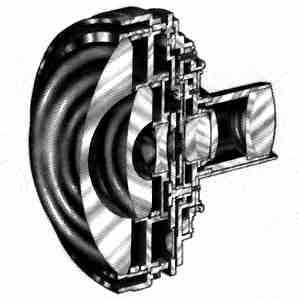 |
| 220° in cross-section, the Fisheye-Nikkor 6mm, f/5.6. |
| The first representative of this type was the Fisheye-Nikkor 8mm,f/8 from 1962, with nine elements and an enormous angle of view of 180°, creating a circular image 24mm in diameter on the film. This lens is not a retrofocus construction; before mounting it on the camera the mirror has to be locked up because the rear element comes less than 1cm from the shutter. |
| The separate viewfinder DF-1 only covers an angle of 160°. Focusing is not necessary with a depth-of-field from 0.5m to infinity at full aperture. Six filters are built-in and can be rotated into the light path. The successor to this lens was the Fisheye-Nikkor 7.5mm,f/5.6 with almost identical specification and features except for its one stop faster speed. |
| In 1968 a very special fisheye was introduced, the Fisheye-Nikkor 10mm, f/5.6 OP, designed for scientific applications. OP stands for ''orthographic projection'' which permits the exact measurement of brightness distribution. This lens shows no light fall-off towards the corners and is still Nikon`s only lens incorporating a plastic element. |
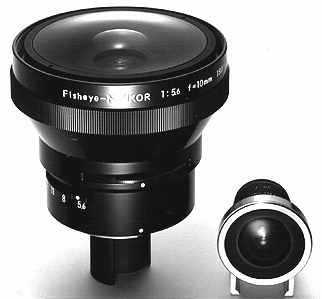 |
| The Fisheye-Nikkor 10mm, f/5.6 OP |
|
In 1969 Nikon`s next fisheye followed in the form of the Fisheye-Nikkor 6mm,f/5.6, displaying an almost unbelievable
picture angle of 220°. This results in parts of the photographer`s surroundings that are situated laterally behind him
being included in the image. Space is so restricted behind the huge front of the lens that the aperture has to be set by a lever.
In 1970 the Fisheye-Nikkor 8mm,f/2.8 was introduced, the first such lens in a retrofocus design. This allows normal viewing on the focusing screen in spite of the angle of view of 180°. Thanks to its relatively light weight of 1100g photographers who don't get dizzy easily can even risk hand-held shots. |
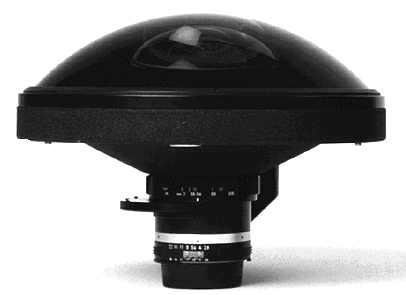 |
| A lens that can look behind: the Fisheye-Nikkor 6mm, f/2.8 with a picture angle of 220°. |
| The Fisheye-Nikkor 6mm,f/2.8 represents an awe-inspiring masterpiece of optical design, impressive with its gigantic 20cm front element. In its centre this element is just 7mm thick, growing to 60mm at the edges, and the circular image on the film is 23mm in diameter. This retrofocus construction weighs more than 5 kilos and can be focused down to 25 cm. When it is stopped-down to f/22 the depth-of-field is from 17cm to infinity. |
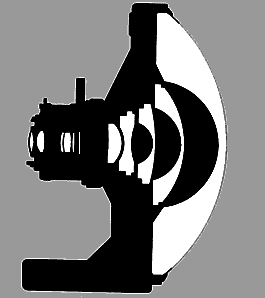 |
| A diagram of a record wide-angle, the Fisheye-Nikkor 6mm, f/2.8. |
| Unlike the fisheye lenses described up to now which produce a circular image, the so-called full-frame fisheyes fill the complete 24x36mm, although they still render straight lines not passing through the lens axis as curved and to an increasing degree the further from the axis they are. This type of lens constitutes an alternative to the distortion-free wide-angles, and the first Nikon representative was the Fisheye-Nikkor 16mm,f/3.5 of 1973. The retrofocus design has resulted in compact dimensions, no more than a 50mm lens. Focusing is possible down to 30 cm, and the four most commonly needed filters are built-in. |
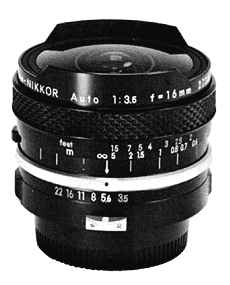 | 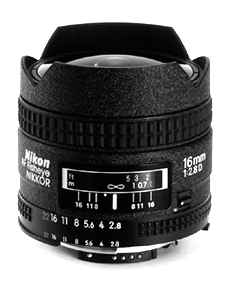 |
| The first version of a full- frame fisheye, the Fisheye- Nikkor 16mm, f/3.5 |
The current version: AF Fisheye-Nikkor 16mm, f/2.8 D |
|
Two years later its successor was introduced, the Fisheye-Nikkor 16mm,f/2.8, with an increased angle of view to
180° as opposed to the earlier 170°. The filters are attached behind the rear element as with the 13mm and 15mm
super-wide-angles. In 1993 the AF-version of this lens was introduced. While the AF Fisheye-Nikkor 16mm,f/2.8 D
optical design remained unchanged, it was matched to the new F90-type cameras, i.e. the CPU relays additional
distance data to the camera exposure control system.
All Nikon fisheye lenses deliver excellent sharpness and contrast. NIC-coating prevents anything more than relatively slight ghost images even when the sun shines directly onto the front element. But light sources should still be kept as close to the optical axis as possible since no effective lenshoods are available for these immense picture angles. |
| back to Nikon COMPENDIUM main page |